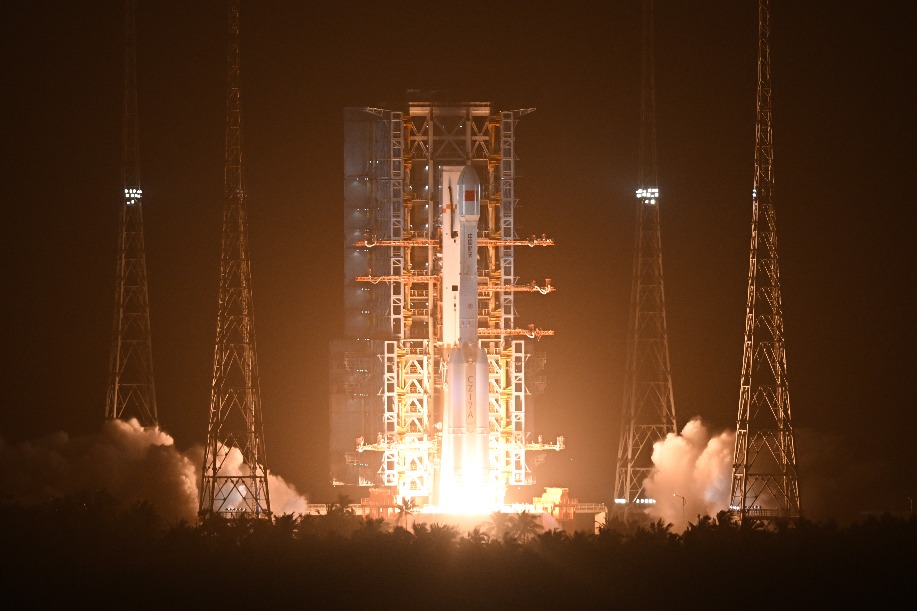New lightbulb set for world debut

China is working closely with British scientists in use of graphene, a new material
When President Xi Jinping visited the University of Manchester in October, he was shown the world's first graphene lightbulb. Manufactured by China's BGT Materials, the bulb will be launched globally this month in Britain, carrying with it the potential to change the lighting industry.
With a long life span and cheap production costs, graphene lightbulbs could become a strong rival to LED lights, and BGT forecasts sales of 300,000 to 500,000 units this year.
| Liam Britnell, Marketing VP of Graphene Lighting PLC, the BGT Materials Limited's spin off company, holds the graphene lights. Provided to China Daily |
Graphene, a thin layer of pure carbon that is tougher than a diamond yet lightweight and easily conducts electricity and heat, was first isolated from graphite in 2004 by Andre Geim and Kostya Novoselov at Manchester University. The duo went on to win the Nobel Prize for physics in 2010.
Due to its short history, though, graphene's commercial potential is yet to be unlocked. It is already used by Austrian sports equipment maker Head to strengthen tennis rackets, while Italian company Vittoria uses it to strengthen bicycle tires.
Since Xi's visit to BGT Materials, which is based in the National Graphene Institute at Manchester University, the institute has signed two deals with Chinese companies: one with Huawei, the other with the Beijing Institute of Aeronautical Materials and Aviation Industry Corp of China.
"The interest among Chinese companies has really taken off since the state visit. We've received so many enquiries," says James Baker, graphene business director at the National Graphene Institute.
The project with Huawei is focused on research into graphene's thermal management properties, while with AVIC the Manchester institute is looking into how to incorporate graphene into materials for aviation and other transport sectors.
Robert Young, a professor of polymer science and technology, who is leading the National Graphene Institute's project with AVIC, says the use of graphene in the transport industry can lead to significant benefits.
"Graphene is a strong, lightweight material, and in the transport industry it's important to save weight to be fuel-efficient," he says.
China has already made graphene a strategically important new material in its 13th Five-Year Plan, which sets out the country's development objectives between 2016 and 2020.
The country has also set up five industrial parks to accelerate its industrialization, in Changzhou, Wuxi, Ningbo, Qingdao, and Chongqing.
Currently, 70 percent of graphite is found in China, giving Chinese manufacturers a big advantage, while according to Britain's National Physical Laboratory, China has applied for 47 percent of the world's graphene patents.
All these efforts are aimed at unlocking China's huge market potential. ResearchInChina, an intelligence firm in Beijing, forecasts that China's graphene market will grow to 200 million yuan ($30.6 million; 27 million euros) in 2018, compared with a global market of $65 million. The global market last year was worth $24.4 million.
"China's high-technology manufacturing industry, its ability to invest heavily in graphene, and its abundance of highly qualified talent all contribute to the country's advantages," Young says.
China has also placed a big emphasis on the implementation of high-quality graphene standards domestically, with the help of British expertise.
In March last year, the National Physical Laboratory signed an agreement with Beijing's Zhongguancun Fengtai Science Park and Beijing Fengtai New Materials Inspection Institute to help Chinese organizations adapt global graphene standards to specific needs.
Hao Ling, the lab's principal research scientist, says enforcing standards internationally is vital for the industry's growth. "By having a national standard in China in line with international standards, we can certify the graphene output so that international importers will want to buy from Chinese manufacturers."
Currently, two bodies develop the global standards: the International Organization for Standardization and the International Electrotechnical Commission.
"Graphene has risen up the Chinese government's agenda, shown by its recognition of graphene as a key new material in the 13th Five-Year Plan and the establishment of the International Graphene Center in Beijing last year," Hao says. "Given these investments, China's graphene research will grow and China could contribute more to discussions on international graphene standards."
cecily.liu@mail.chinadailyuk.com
(China Daily European Weekly 05/20/2016 page25)
Today's Top News
- Takaichi must stop rubbing salt in wounds, retract Taiwan remarks
- Millions vie for civil service jobs
- Chinese landmark trade corridor handles over 5m TEUs
- China holds first national civil service exam since raising eligibility age cap
- Xi's article on CPC self-reform to be published
- Xi stresses improving long-term mechanisms for cyberspace governance































